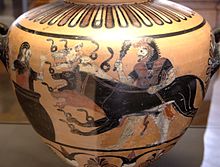 |
| Detail of sculpture of god Hades with Cerberus |
Mythology
 |
| Cerberus outside the entrance to the Royal Institute of Technology in Stockholm. |
The Twelfth Labor of Heracles
Capturing Cerberus, without using weapons, was the final labour assigned to Heracles (Hercules) byKing Eurystheus, in recompense for the killing of his own children by Megara after he was driven insane by Hera, and therefore was the most dangerous and difficult.
After having been given the task, Heracles went to Eleusis to be initiated in the Eleusinian Mysteries so he could learn how to enter and exit the underworld alive, and in passing absolve himself for killing centaurs. He found the entrance to the underworld at Tanaerum, and Athenaand Hermes helped him to traverse the entrance in each direction. He passed Charon with Hestia's assistance and his own heavy and fierce frowning.
Whilst in the underworld, Heracles met Theseus and Pirithous. The two companions had been imprisoned by Hades for attempting to kidnap Persephone. One tradition tells of snakes coiling around their legs then turning into stone; another tells that Hades feigned hospitality and prepared a feast inviting them to sit. They unknowingly sat in chairs of forgetfulness and were permanently ensnared. When Heracles had pulled Theseus first from his chair, some of his thigh stuck to it (this explains the supposedly lean thighs of Athenians), but the earth shook at the attempt to liberate Pirithous, whose desire to have the wife of a god for himself was so insulting, he was doomed to stay behind.
Heracles found Hades and asked permission to bring Cerberus to the surface, to which Hades agreed if Heracles could overpower the beast without using weapons. Heracles was able to overpower Cerberus and proceeded to sling the beast over his back, dragging it out of the underworld through a cavern entrance in the Peloponnese and bringing it to Eurystheus. The king was so frightened of the beast, he jumped into a pithos, and asked Heracles to return it to the underworld in return for releasing him from his labours.
Literature
Cerberus featured in many prominent works of Greek and Roman literature, most famously inVirgil's Aeneid, Peisandros of Rhodes' epic poem the Labours of Hercules, the story ofOrpheus in Plato's Symposium, and in Homer's Iliad, which is the only known reference to one of Heracles' labours which first appeared in a literary source.
The depiction of Cerberus is relatively consistent between different works and authors, the common theme of the mane of serpents is kept across works, as is the serpent's tail, most literary works of the era describe Cerberus as having three heads with the only notable exception being Hesiod's Theogony in which he had 50 heads.
Most occurrences in ancient literature revolve around the basis of the threat of Cerberus being overcome to allow a living being access to the underworld; in the Aeneid Cerberus was lulled to sleep after being tricked into eating drugged honeycakes and Orpheus put the creature to sleep with his music. Capturing Cerberus alive was the twelfth and final labour of Heracles. In Dante Alighieri's Inferno, Canto VI, the "great worm" Cerberus is found in the Third Circle of Hell, where he oversees and rends to pieces those who have succumbed to gluttony, one of the seven deadly sins.
In the constellation Cerberus introduced by Johannes Hevelius in 1687, Cerberus is sometimes substituted for the "branch from the tree of the golden apples" fetched by Atlas from the garden of the Hesperides. This branch is the literary source of the "golden bough" in the Aeneid by Virgil.
In Paradise Lost 11.65, Cerberean hounds are mentioned in Hell: "A cry of Hell Hounds never ceasing bark'd With wide Cerberean mouths full loud".
Art
Numerous references to Cerberus have appeared in ancient Greek and Roman art, found inarchaeological ruins and often including in statues and architecture, inspired by the mythology of the creature. Cerberus' depiction in ancient art is not as definitive as in literature; the poets and linguists of ancient Greece and Rome mostly agreed on the physical appearance (with the notable exception in Hesiod's Theogony in which he had 50 heads). His depiction in classical art mostly shows the recurring motif of serpents, but the number of heads differs.A statue in the Galleria Borghese depicts Cerberus with three heads sitting by the side of Hades, while a bronze sculpture depicting Heracles' twelfth labour shows the demi-god leading a two-headed Cerberus from the underworld. The majority of vases depicting the twelfth task also show Cerberus as having two heads. Classical critics have identified one of the earliest works of Cerberus as "the most imaginative," that being a Laconian vase created around 560 BC in which Cerberus is shown with three-heads and with rows of serpents covering his body and heads.
Etymology
The name "Cerberus" is a Latinised version of the Greek Kerberos. The etymology of this name prior to Greek is disputed. It has been claimed to be related to the Sanskrit word सर्वरा "sarvarā", used as an epithet of one of the dogs of Yama, from a Proto-Indo-Europeanword *k̑érberos, meaning "spotted" (This etymology suffers from the fact that it includes a reconstructed *b, which is extremely rare in Proto-Indo-European. Yet according to Pokorny it is well distributed, with additional apparent cognates in Slavic, British and Lithuanian.) The use of a dog is uncertain, although mythologists have speculated that the association was first made in the city of Trikarenos in Phliasia. Bruce Lincoln (1991), among others, critiques this etymology; and Ogden (2013) refers to it as "dismissed".
Lincoln notes a similarity between Cerberus and the Norse mythological dog Garmr, relating both names to a Proto-Indo-European root*ger- "to growl" (perhaps with the suffixes -*m/*b and -*r). However, as Ogden observes, this analysis actually requires Cerberus andGarmr to be derived from two different Indo-European roots (*ger- and *gher- respectively), and so does not actually establish a relationship between the two names.
Explanations
There have been many attempts to explain the depiction of Cerberus. A 2nd century CE Greek known as Heraclitus the paradoxographer--- not to be confused with the 5th century BCE Greek philosopher Heraclitus--- claimed euhemeristically that Cerberus had two pups which were never away from their father, and that Cerberus was in fact a normal (though very large) dog, but that artists incorporating the two pups into their work made it appear as if his two children were in fact extra heads. Classical historians have dismissed Heraclitus the paradoxographer's explanation as "feeble". Mythologers have speculated that if Cerberus was given his name in Trikarenos it could be interpreted as "three karenos". Certain experts believe that the monster was inspired by the golden jackal.

This work is licensed under a Creative Commons Attribution-ShareAlike 3.0 Unported License.




 04:20
04:20
 Planet Worldwide
Planet Worldwide





 Posted in:
Posted in:
0 comments:
Post a Comment